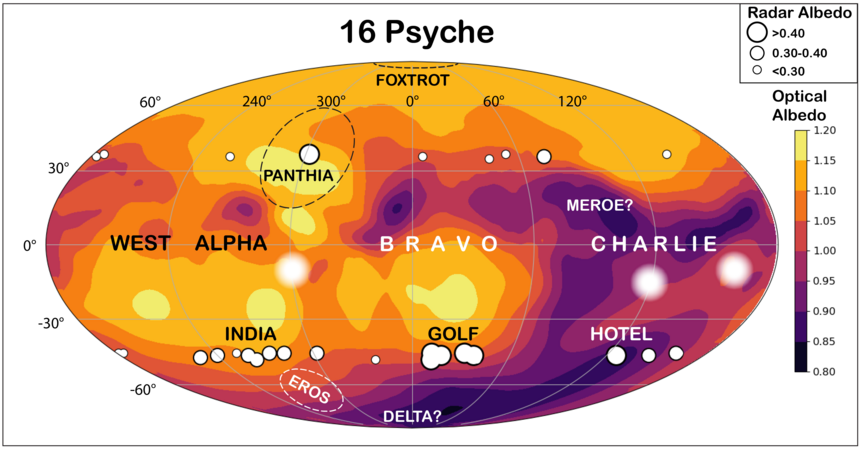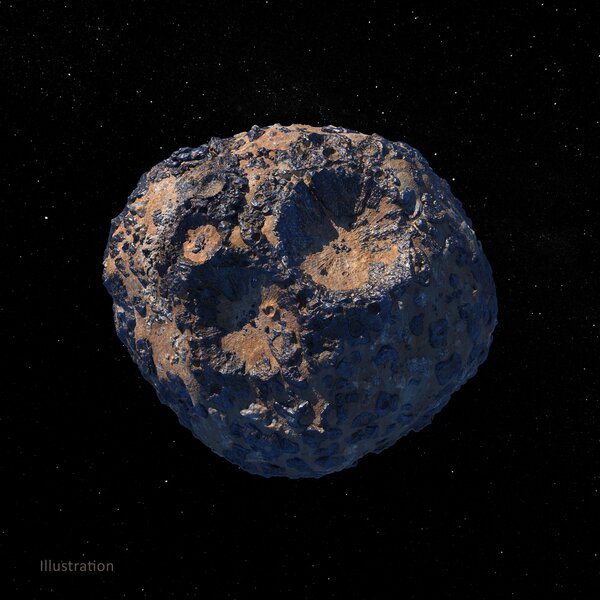Create a free profile to get unlimited access to exclusive videos, sweepstakes, and more!
Psyche is the most metal asteroid: It may have volcanoes that spewed molten iron

I'm very excited about the Psyche mission. Due to launch next year, this NASA spacecraft will arrive at its target in the main asteroid belt four years later: The odd asteroid 16 Psyche.
Most asteroids are rocky, and some even have ice under their surface, but Psyche is an M-class asteroid, meaning it’s highly metallic (mostly iron and nickel). It’s big, over 200 kilometers across, and quite shiny — a typical asteroid reflects roughly 4% of the sunlight hitting it, but Psyche reflects 16%. Again, that makes sense if it’s metallic.
All asteroids visited by spacecraft so far are rocky, so Psyche will be the first of its kind to be seen up close. It’s always been a fascinating object, but the upcoming mission has ramped up interest in it as well.
A paper just published by a team of scientists* has some interesting updates on this odd little metal world.
They used observations of Psyche by the Very Large Telescope, the enormous Keck telescope, ALMA, Arecibo, and even stellar occultations to determine the size, shape, and surface topography of the asteroid. Their results are quite interesting.
Overall, Psyche is shaped like a flat potato, measuring 278 × 238 × 171 km in size (± roughly 5 km), consistent with though more accurate than previous measurements made in the past, and it spins once every 4.2 hours.
They find several large surface features, including a large depression they call Alpha (they designate the features using radio call signs for the alphabet) and two large flat regions called Bravo and Charlie. At the asteroid’s north pole is a 50-km feature (Foxtrot) that may be an impact crater, and another near the south pole (Eros).
The next features need a bit of back story. As Psyche spins, it gets brighter and dimmer in visible and infrared light over time as more and less reflective spots on the surface come into view; the observations using Keck and VLT can be used to map out where they are.
The Arecibo observations use radar. These radio waves were sent out by the huge dish, hit the asteroid, and are reflected back to Earth. This can be used to map out the shape of the asteroid (a radar ping that hits a depression has to travel a slight bit longer to get there and back, for example, so timing those can generate topographical maps), but the strength of the returned signal also can give clues about the surface composition as well.
And this is where things get interesting indeed. In several spots on the asteroid, they found both visible light and radar were reflected well. This means those spots are shiny in both wavelengths.
Why is that significant? It’s not clear how Psyche formed. Billons of years ago smaller bodies called planetesimals slammed into each other and grew. Some of them were rocky, some metal. Once the growing object started to get big enough to have noticeable gravity, the molten metals would sink to the core and the lighter rocky material would float to the top. This process is called differentiation.
An idea that’s been around a long time is that after this happened Psyche suffered a monumental impact that sheared off its outer layers, leaving behind just the metal core. But estimates of its density put it around 4 grams per cubic centimeter, while iron has a density twice that. If it’s a pure metal world, that density hard to explain.
But there are other ideas, too. One is that it had multiple impacts that shattered it into smaller chunks that reaccumulated. That would mean it’s porous, like a box of rocks and metal chunks instead of one solid body. We see smaller asteroids like that, but Psyche is 100 times larger than those, and it’s not clear that anything that big can be that porous.
The paper authors have another idea: Psyche is still a differentiated world, with a metal core and rocky crust… but it’s ferrovolcanic.
I’ve written about this before. On Earth, volcanism is from molten rock, and on some asteroids and icy moons (and Pluto of that matter) we see evidence of cryovolcanoes, eruptions of liquid water that freezes into a solid. Ferrovolcanoes are eruptions of molten iron, which is one of the coolest things ever. Their idea is that the core stayed molten while the surface cooled into a rocky crust, but the molten metal would have erupted out where the crust was thinner.
That would explain the observations: It’s been shown that there’s plenty of rock on the surface, but it’s liberally mixed with metal. The surface regions they found that were bright both in visible light and radar would be the locations of these ferrovolcanoes. The metal flowing out would solidify and be reflective to both wavelengths of light.
The beauty of this is that it makes a clear prediction: When the spacecraft gets there, if it sees those spots are ferrovolcanoes, it’s strong support that Psyche is differentiated, and not the naked core of what was once a much larger object.
So, in just a few years, we’ll find out if they’re right.
Now, as far as my excitement over this mission and asteroid go, I’m biased. I collect meteorites, which are chunks of asteroids that have fallen to Earth. I have a few rocky ones, but I prefer the metal ones. To me they’re just intrinsically cooler. Metal asteroids are rare, and Psyche is by far the largest one. It’s possible that some meteorites are actually from Psyche.
I’m not saying any of the meteorites I have are from Psyche, but it does make the connection to the asteroid more tangible to me. And in just five years, we’ll have our first close-up images and data from an M-class asteroid. I cannot wait to see what it looks like.
*My thanks to lead author Michael Shepard for sending me a note about this paper.















